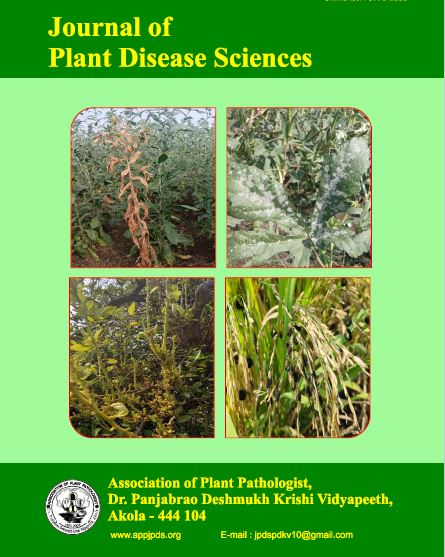HARNESSING DEFENCE INDUCERS FOR THE MANAGEMENT OF POWDERY MILDEW IN LINSEED
DOI:
https://doi.org/10.48165/jpds.2025.20.01.11Keywords:
Defence inducers, Fungicides, Linseed, Powdery mildewAbstract
Linseed suffers significant grain yield losses due to various abiotic and biotic stress factors, with powdery mildew caused by Oidium lini (Skoric) being one of the most critical biotic threats. This disease reduces photosynthetic efficiency and grain yield, manifesting in symptoms such as drooping and yellowing of leaves, reduced capsule number, and smaller seed size. To address this, a study was conducted from 2019–2020 to 2021–2022 to evaluate the effectiveness of defence inducers and a fungicide in managing powdery mildew.The treatments included salicylic acid (50 and 100 ppm), monopotassium phosphate (1%), sodium propionate (1%), and hexaconazole (0.1%). Among these, seed treatment followed by foliar application of salicylic acid at 50 ppm at 30 and 45 days after sowing (DAS) showed the highest disease reduction (34.99%), maximum seed yield (1219 kg/ha), and the highest incremental cost-benefit ratio (ICBR) of 1:6.71.These findings underscore the potential of systemic acquired resistance (SAR) and induced systemic resistance (ISR)-based inducers as eco-friendly alternatives to conventional fungicides in the sustainable management of powdery mildew in linseed.
References
Anonymous, 2023: Annual Report Linseed 2022–23. ICAR–Indian Institute of Oilseeds Research, Rajendranagar, Hyderabad–500 030.
Awad, M.E.M., Abo-Elyousr, K.A.M.F. and Abdel-Monaim, H., 2011: Management of cucumber powdery mildew. Archives of Phytopathology and Plant Protection, 45(6): 652–659.
Gill, K.S., 1958: Powdery mildew, a new disease of linseed in Punjab. Indian Oilseeds Journal, 2: 16–17.
Hamza, A.A., Mohamed, A.E. and Derbalah, A.S., 2017: Chemical inducers for resistance induction against powdery mildew of cucumber under greenhouse conditions. Acta Phytopathologica et Entomologica Hungarica, 52(1): 49–60.Kushwah, U.S. and Chand, J.N., 1971: Efficacy of fungicides for control of powdery mildew of linseed (Linum usitatissimum) caused by Oidium lini. Indian Phytopathology, 24: 200.
Mckinney, H.H., 1923: Influence of soil temperature and moisture on infection of wheat seedlings by Helminthosporium sativum. Journal of Agricultural Research, 26: 195–217.
Sharma, H.C. and Khosla, H.K., 1976: Fungicidal control of powdery mildew of linseed (Linum usitatissimum) in relation to losses. JNKVV Research Journal, 10: 161–162.
Singh, J., Singh, P.K. and Srivastava, R.L., 2017: Diseases of linseed (Linum usitatissimum) in India and their management – A Review. Journal of Oilseeds Research, 34(2): 52–69.

